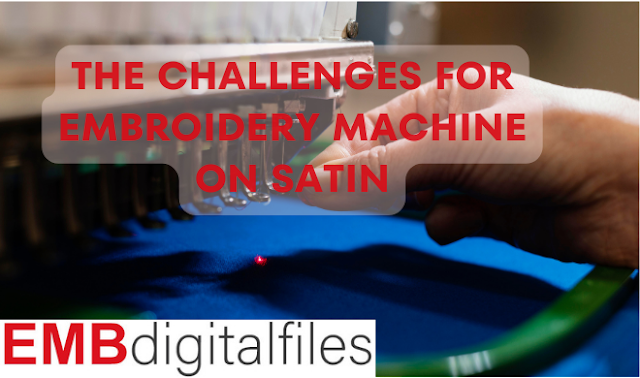Embroidery, a timeless craft, has evolved with the introduction of modern machinery. While embroidery machines have brought efficiency to the craft, they face unique challenges when it comes to working on delicate fabrics like satin. In this article, we will explore the intricacies of satin embroidery and the hurdles embroidery machines encounter, along with effective solutions.
1. The Challenges For Embroidery Machine on
Satin
a. Definition of Embroidery Machine on Satin
Embroidery machines on satin involve the intricate art
of stitching
designs onto this glossy, smooth fabric. Satin's characteristics pose a set
of challenges that demand attention and skill.
b. Importance of Challenges in Embroidery
Understanding and overcoming these challenges is crucial
for achieving flawless
embroidery on satin, ensuring the quality of the final product.
2. Understanding Satin Fabric
Satin, known for its luxurious sheen and smooth texture,
presents challenges due to its delicate nature. The fabric's weave, with a
glossy front and dull back, requires careful
handling during embroidery.
b. Why Satin Poses Challenges for Embroidery Machines
Satin's tendency to fray and slip can lead to issues
like thread tension problems, needle breakage, and design distortion during the
embroidery process.
3. Challenges Faced by Embroidery Machines
a. Thread Tension Issues
Maintaining the right thread tension on satin is
crucial. Too tight or too loose tension can result in uneven stitching and a
less-than-perfect finished product.
b. Needle Breakage
The delicate nature of satin can lead to frequent needle
breakage, disrupting the embroidery process. Choosing the right needle becomes
paramount.
c. Design Distortion
Satin's slippery surface may cause design distortion
during stitching, affecting the accuracy of the embroidered pattern.
d. Hoop Slippage
Hoop slippage is a common challenge when embroidering on
satin, impacting the alignment of the design. Proper hooping techniques are
essential to address this issue.
4. Solutions to Overcome Challenges
a. Adjusting Thread Tension
Calibrating the thread tension according to satin's
characteristics ensures smooth and even stitches.
b. Choosing the Right Needle
Opting for a finer needle helps prevent breakage and
ensures precise embroidery on satin.
c. Using Stabilizers
Stabilizers provide the necessary support for satin,
reducing the risk of design distortion.
d. Proper Hooping Techniques
Ensuring the fabric is securely hooped minimizes the
chances of slippage and misalignment during embroidery.
5. Advanced Techniques for Embroidering on
Satin
Reducing the machine's stitching speed prevents stress
on the delicate satin fibers, enhancing the quality of the embroidered design.
b. Using Water-Soluble Topping
Water-soluble topping adds a protective layer,
preventing the needle from catching on satin fibers and reducing the risk of
fraying.
c. Experimenting with Needle Sizes
Trying different needle sizes allows for customization
based on the specific satin fabric, minimizing breakage and distortion.
d. Regular Machine Maintenance
Routine maintenance ensures the embroidery machine
operates smoothly, preventing unexpected issues during satin embroidery.
6. Tips for Choosing the Right Embroidery
Machine
Selecting an embroidery machine with features
specifically designed for satin work, such as adjustable thread tension and
slow stitching options.
b. User Reviews
Exploring user reviews provides insights into the
experiences of others, helping in making an informed decision.
c. Professional Recommendations
Seeking recommendations from embroidery professionals
can guide enthusiasts toward machines known for their satin embroidery
capabilities.
d. Budget Considerations
Balancing features and budget is crucial when investing
in an embroidery machine, ensuring it meets both performance and financial
expectations.
7.
Real-Life Success Stories
Examples of businesses thriving in satin embroidery,
sharing their strategies for success.
b. Personal Experiences Shared by Users
Testimonials from individuals who have conquered satin
embroidery challenges, offering inspiration to fellow enthusiasts.
Conclusion
a. Recap of Challenges and Solutions
In conclusion, satin embroidery presents challenges
that, with the right knowledge and techniques, can be overcome. Adjusting
thread tension, choosing the right needle, and utilizing
advanced techniques are keys to successful satin embroidery.
b. Encouragement for Embroidery Enthusiasts
To all embroidery enthusiasts, embrace the challenges
posed by satin. With dedication and the right approach, you can master the art
of satin embroidery and create stunning, flawless designs.
FAQs:
- Can
any embroidery machine handle satin fabric?
- Yes,
but it's recommended to choose a machine with features specifically
designed for satin embroidery.
- How
can I prevent needle breakage when embroidering on satin?
- Opt
for a finer needle and reduce stitching speed to minimize stress on the
delicate fabric.
- Is
it necessary to use stabilizers for satin embroidery?
- Yes,
stabilizers provide essential support, reducing the risk of design
distortion on slippery satin.
- What
should I consider when choosing an embroidery machine for satin work?
- Look
for features like adjustable thread tension, slow stitching options, and
consider user reviews for real insights.
- Can
beginners master satin embroidery?
- With
dedication, practice, and following the right techniques, beginners can
indeed master satin embroidery.








0 Comments